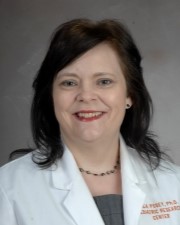
Karen Posey, PhD
- Associate Professor, Pediatric Research Center
Education
- Graduate School
- University of Houston, Houston, Texas, 2000
- Postdoc
- Texas A&M Institute of Biotechnology, Houston, Texas, 2000-2003
Areas of Interest
Research Interests
The goal of my research is to define the molecular mechanisms that contribute to cartilage-related conditions in order to develop therapeutics that improve cartilage and joint health to improve the quality of life of individuals with dwarfing conditions and osteoarthritis. I study pseudoachondroplasia (PSACH), a severe dwarfing condition associated with severe and osteoarthritis early-onset. Using our pseudoachondroplasia mouse model, we defined the mechanisms underlying chondrocyte dysfunction and loss, a self-perpetuating pathological loop between ER stress, inflammation and oxidative stress, which revealed drug targets. Understanding the pathological loop between ER stress, inflammation and oxidative stress is very exciting because there is growing evidence that this pathological mechanism may be involved in many other ER stress related conditions such as neurodegenerative disorders and diabetes and has provided a foundation for the development of the first therapies for pseudoachondroplasia. We have investigated readily-available and well-tolerated antioxidants and anti-inflammatory agents to dampen the intracellular ER retention chondrocyte pathology. This approach may work on many types of secretory cells (chondrocytes, neurons, islet cells…) interrupting the ER stress-inflammation-oxidative stress loop pathology. If this type of inexpensive and well-tolerated therapy could be applied to the early stages of neurodegenerative disorders and metabolic syndrome, onset may be delayed or the pathology suppressed effecting a revolution in health care and the impact of these devastating conditions. Additionally, this pseudoachondroplasia mouse model has lead me to expand my work into the field of osteoarthritis because early-onset osteoarthritis is associated with this dwarfing condition. The inducible feature of the model allows the stimulation of ER stress in adult articular chondrocytes in order to assess the role that ER stress plays in osteoarthritis establishment and progression. Our recent findings suggest that ER stress may be a major component in idiopathic osteoarthritis.
Publications
Posey, K.L., Veerisetty, A.C., Liu, P., Wang, H.R., Poindexter, B.J., Bick, R., Alcorn, J. L., Hecht, J.T.: An inducible COMP mouse model recapitulates human PSACH phenotype. Am J Pathol 175(4):1555-63, 2009.
Posey, K.L., Liu, P., Wang, H.R., Veerisetty, A.C., Alcorn, J. L., Hecht, J.T.: RNAi Reduces Expression and Intracellular Retention of Mutant Cartilage Oligomeric Matrix Protein (COMP). Plos One 5(4):e10302, 2010.
Li H., Haudenschild D.R., Posey K.L., Hecht J.T., Di Cesare P.E., Yik J.H.: Comparative analysis with collagen type II distinguishes cartilage oligomeric matrix protein as a primary TGFβ-responsive gene. Osteoarthritis Cartilage. 19(10):1246-53, 2011.
Posey K.L., Coustry F., Veerisetty A.C., Liu P., Alcorn J.L., Hecht J.T.: Chop (Ddit3) is essential for D469del-COMP retention and cell death in chondrocytes in an inducible transgenic mouse model of pseudoachondroplasia. Am J Pathol 180(2):727-37, 2012.
Coustry F., Posey K.L., Liu P., Alcorn J.L., Hecht J.T.: D469del-COMP retention in chondrocytes stimulates caspase-independent necroptosis. Am J Pathol 180(2):738-48, 2012.
Posey K.L., Coustry F., Veerisetty A.C., Liu P., Alcorn J.L., Hecht J.T.: Chondrocyte-specific pathology during skeletal growth and therapeutics in a murine model of pseudoachondroplasia. J Bone Miner Res.;29(5):1258-68, 2014.
Posey K.L., Alcorn J.L., Hecht J.T.: Pseudoachondroplasia/COMP – translating from the bench to the bedside. Matrix Biol. 37C:167-173, 2014
Posey K.L., Coustry F., Veerisetty A.C., Hossain M., Alcorn J.L., Hecht J.T: Antioxidant and anti-inflammatory agents mitigate pathology in a mouse model of pseudoachondroplasia. Hum Mol Genet. 15;24(14):3918-28. 2015.